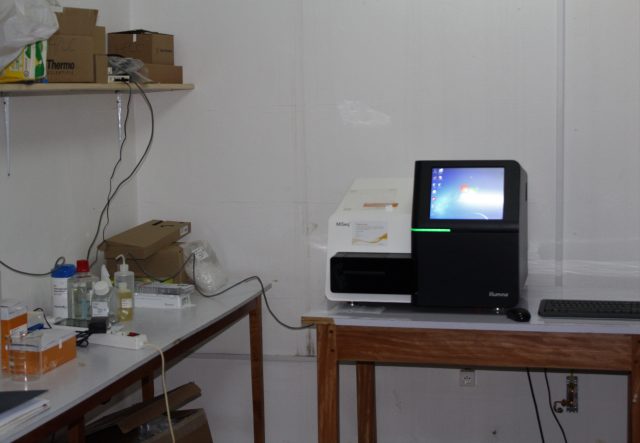It is a Mid-throughput sequencer, capable of generating up to 15 Gigabytes data with 50 million paired-end sequencing reads. The acquisition of this cutting edge technology is another step forward towards achieving high quality research.

Miseq in CRID lab
Miseq is one of the smallest benchtop sequencers. It helps on-site at the Centre for Research in Infectious Diseases (CRID), to determine the genetic composition of mosquitos and other arthropod vectors. It can also be used to determine the genetic composition of an individual or a plant. Its ability to sequence many samples at the same time is one of its key functions. Up to 96 samples may be sequenced in a single run with Deoxyribonucleic Acid (DNA) libraries prepared with indexed or bar-coded adapters. This device has numerous applications including small genome sequencing, targeted gene sequencing, Ribonucleic Acid (RNA) sequencing (RNA-Seq) and 16S metagenomic sequencing. As a sequencing machine, most people use it to identify any change or mutation at the genetic level that could cause various phenotypic traits. For vector biologists or medical entomologists, it could be used to identify genetic changes associated with insecticide resistance, molecular identification of mosquitoes, pathogens detection and drug resistance. Moreover, with the COVID-19 crisis and the different variants that exist which are due to mutations in the genetic make-up of the virus, Miseq can be used by CRID researchers to look at the genetic make-up of COVID-19 virus. It can help to sequence the virus, to determine if there are different variants circulating or not. For CRID, this device is very important, It is a huge step towards reaching it goal of becoming a genomic Centre of Reference in Africa. At CRID, there are several researchers undertaking genomic studies which require sequencing. At first most of our sequencing was outsourced and done abroad, at unnecessary expense, often with long delays and without any assistance on experimental design, sample preparation, or bioinformatics. The acquisition of this device will provide a new valuable research platform for CRID. Nonetheless, this piece of technology will build the capacity of students and researchers at CRID, in Cameroon and even in Africa with skills and Knowledge in genomic sequencing.

This sequencer is capable of generating up to 15 Gigabytes data with 50 million paired-end sequencing reads
From August 17-18, 2021, researchers at CRID had a training session organised by Illumina, the company from which the device was purchased. During this training, the researchers were drilled on how to operate the device and run samples or analysis. The trained was both theoretical and practical. Theoretically, they were trained on the basics, software, and chemistry behind this cutting edge technology while practically, a control sample from Illumina was sequence to check if the device functions properly. Most researchers at CRID focus on vector borne-diseases and how mosquitos become resistant to insecticides used in public health. Therefore, this device will help in the identification of mutations that are causing resistance and from these mutations, a molecular tool could be designed to track the spread of these mutations in the field. With the results obtained, these researchers would be able to propose innovative control strategies to help the National Malaria Control Programme (NMCP) make evidence-based decisions vis-à-vis the control and elimination of mosquito borne-diseases. For many, it is the first time they are seeing a Miseq sequencer; a great privilege because majority of students and some researchers in sub-Sahara Africa spend their whole curriculum just hearing about a sequencer without ever seeing what a Miseq sequencer looks like or knowing how to operate it. It is a unique opportunity for PhD students and researchers to be in a research centre where they could operate such a sophisticated device on daily basis.





